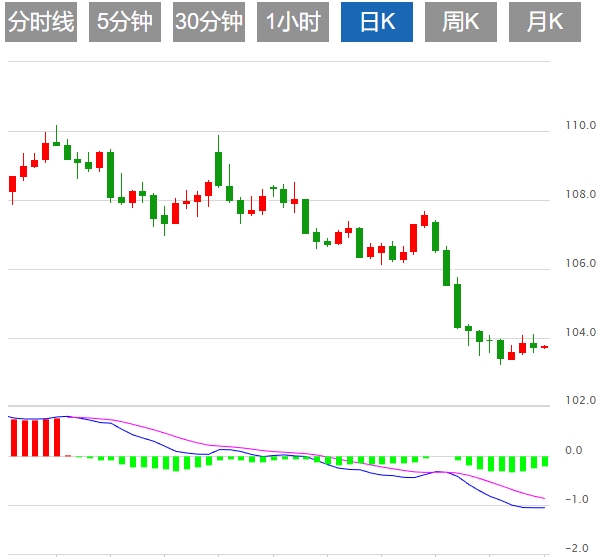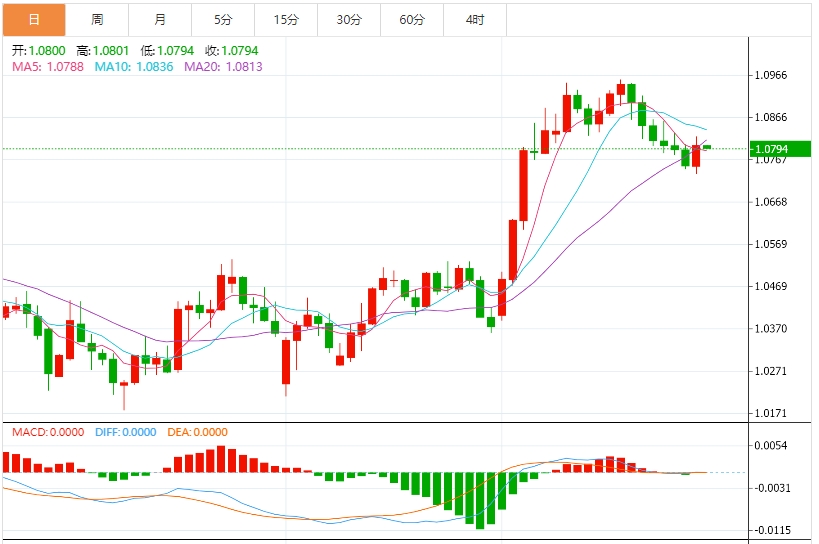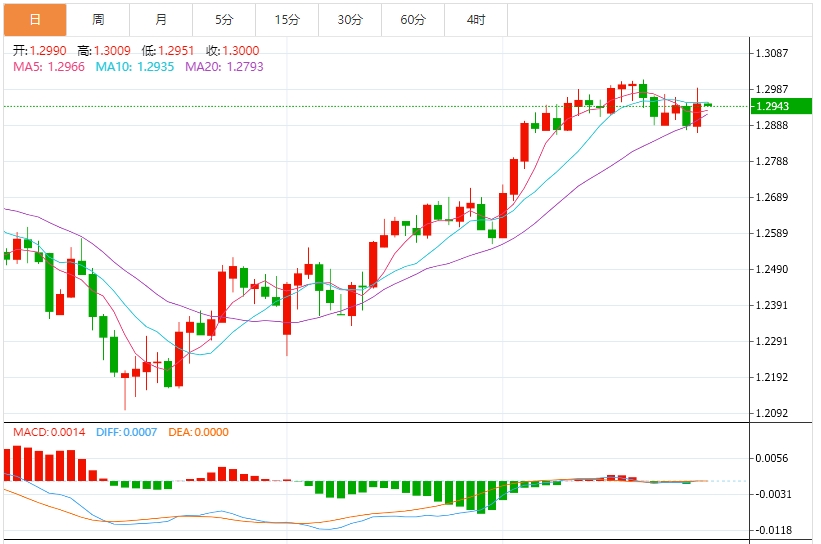In the Asian session on Monday, the US dollar index hovered around 103.83, down 0.17% on the day. This week, the focus is on the implementation of global trade tariffs on Wednesday and the non-farm payrolls report on Friday, which may strengthen the safe-haven appeal of gold. Other important data include ISM manufacturing PMI and JOLTS job vacancies on Tuesday, ADP employment on Wednesday, and ISM non-manufacturing PMI and initial jobless claims on Thursday.
US dollar: As of press time, the US dollar index fluctuated narrowly and is now around 103.83. Due to the risk of stagflation in the United States, the US dollar (USD) has faced certain selling pressure for the third consecutive day. Technically, the US dollar index (DXY) continued to consolidate around the 104.30 area after a mild reaction after PCE. The dollar is likely to see a quarterly decline this week as concerns about slowing US economic growth due to tariffs push down US bond yields, stocks and the dollar exchange rate. While the Moving Average Convergence Divergence (MACD) gave a buy signal, momentum indicators remain mixed. The momentum oscillator remains stable, indicating low trend strength. The bearish backdrop is supported by the 20-day, 100-day and 200-day simple moving averages (SMAs) and the 10-day and 30-day exponential moving averages (EMAs), which are all pointing lower. Resistance is located at 104.118, 104.145 and 104.472, while the immediate support is at 103.951.

Euro: As of press time, EUR/USD hovered around 1.0841. The EUR/USD pair attracted some bargain-hunting buying after dipping to around 1.0800 in the Asian session and is expected to rebound from the multi-week lows hit last Thursday. On the other hand, the common currency seems to be supported by the easing of EU-US trade war concerns. In fact, the European Commission (EC) said it has prepared concessions for the United States to escape Trump's so-called reciprocal tariffs, which Trump will announce on Wednesday. However, the general risk aversion may provide some support to the safe-haven dollar and limit the upside of the EUR/USD pair. Technically, momentum indicators are mixed. The short-term relative strength index is at a neutral level of 5.91, and when combined with the stochastic indicator, it confirms the lack of a clear directional drive. The Moving Average Convergence Divergence (MACD) is giving a sell signal, while the long-term RSI (14) is around 57. Bull Bear Power is also slightly negative, indicating slight hesitation despite the recent gains. However, the moving averages paint a more optimistic picture. The 20-day Simple Moving Average (SMA) at 1.0791, the 100-day SMA at 1.0518, and the 200-day SMA at 1.0729 all indicate buying conditions, reinforcing the current bullish structure.

GBP: As of press time, GBP/USD hovered around 1.2963. The British pound (GBP) remained firm, hovering around 1.2950 with little change against the US dollar (USD). Traders are digesting the latest US inflation report while feeling uncertain about the potential escalation of the trade war after Trump imposed tariffs on cars. The UK economic calendar will remain blank this week. In the United States, traders are watching Trump's tariff announcement for April, the ISM manufacturing PMI for March, JOLTs job vacancies and non-farm payrolls. Technically, GBP/USD traded sideways in Friday's trading without showing a clear bias, but a daily close near 1.3000 could pave the way for further gains. This is because buyers prevented the bears from pulling the exchange rate below 1.2900, preventing the pair from testing the 200-day simple moving average (SMA) of 1.2802. Nevertheless, bulls are not out of the woods. Although the relative strength index (RSI) is bullish, it shows that the momentum has weakened after retreating from the overbought area.

Japan's industrial output in February recorded the fastest growth in nearly a year, as manufacturers sought to meet strong demand before the United States imposed new tariffs on automobiles and auto parts. Data on Monday showed that industrial output rose 2.5% month-on-month in February, the first increase in four months and the fastest growth since March last year. Retail sales rose 0.5% month-on-month in February, slightly better than expected, and rose 1.4% year-on-year. Monday's data is consistent with the Bank of Japan's assessment that the economy has recovered modestly, although there are still some weak links. Japanese authorities will pay close attention to whether the rebound in output can be sustained amid rising U.S. tariffs.
In early trading on Monday, S&P 500 and Nasdaq 100 futures fell more than 0.5%, and there may be more volatility this week as Trump will announce reciprocal tariffs on Wednesday. Chris Weston, head of research at Pepperstone, said: "The market will now be fully influenced by the upcoming large number of tariff-related headlines, while being highly sensitive to any economic data that accelerates the theme of slowing economic activity and expected higher inflation. Risk assets will fall further at the beginning of this week, and cross-asset volatility will rise." Barclays strategists led by Themistoklis Fiotakis wrote in a note to clients: "While there are growing concerns about the weakness of soft data in the United States, hard data has performed better. This makes the job vacancies and non-farm data to be released this week particularly important in assessing the potential damage of tariff uncertainty to the US economy."
According to the Financial Times, since the beginning of the year, Swedish and Norwegian currencies have become the most popular way for traders to bet on the recovery of the European economy, outperforming other major currencies as lawmakers in the region have promised to launch a spending boom. The Swedish krona has climbed more than 10% against the dollar this year, on track for its biggest quarterly gain since 2010; the Norwegian krona has risen more than 8% against the dollar, its biggest gain in more than two years, making them the best performing G10 developed market currencies this year, ahead of the euro and pound, as investors bet on rate hikes in Scandinavian countries and massive spending promises from Germany and other large economies. "Scandinavian currencies are simply the euro on steroids," said Kamal Sharma, a foreign exchange strategist at Bank of America.
U.S. President Trump signed a notice at the White House on the 26th, announcing a 25% tariff on imported cars, which will take effect on April 2. The news has attracted widespread attention from Japanese political and business circles, automakers and the media. Hideo Kumano, chief economist at Dai-ichi Life Research Institute, said that the U.S. tariff policy has no positive effect and will bring risks to the global economy.
US President Trump said he had a call with Canadian Prime Minister Carney on Friday, and the two will meet after the Canadian election. The meeting comes at a time when the tariff war between Canada and the United States, a neighboring ally and major trading partner, is intensifying. Trump said in a post on Truth Social on Friday: "This was a very productive call. We agreed on many things and will meet immediately after Canada's upcoming election to cooperate on politics, business and all other factors, which will ultimately be good for both the United States of America and Canada." After Trump's post was released, the Canadian dollar rose in response, and the US dollar/Canadian dollar USD/CAD fell nearly 50 points in the short term, as low as 1.4277. This is the first call between the two since Carney took office as Canadian Prime Minister on March 14. Carney had previously called for a national election on April 28, and the US threat to Canada's economy and sovereignty has become a major issue in this election.
Economists are mostly unimpressed by Canada's strong GDP growth in January. They say the data is outdated news given that President Trump has so far imposed tariffs on Canadian aluminum and steel, and there will be more measures next week, among which the 25% tariff on automobiles and auto parts is particularly noteworthy. Doug Porter, chief economist at Bank of Montreal Capital Markets, said that GDP grew 0.4% month-on-month in January and flat growth in February, which makes the annualized GDP growth rate in the first quarter expected to reach 1.5% to 2%, which is basically in line with the Bank of Canada's expectations. Given that tariffs are now in place and will increase further, the good start of the economy at the beginning of this year is just a consolation that is better than nothing. Porter said that the data showed that Canada's economy was performing well before the escalation of the trade conflict, which should prompt the Bank of Canada to "continue to choose to wait and see for the time being" in April.
Marc Schattenberg, an economist at Deutsche Bank Research, pointed out in a report that the German labor market cooled further in March and the situation may get worse. He said that the seasonally adjusted unemployment rate rose slightly to 6.3% from 6.2% in February, while the number of unemployed people unexpectedly increased by about 26,000 to 2.92 million. Schattenberg said that unemployment is likely to persist, especially in manufacturing, which is largely due to the impact of US trade policies on key German industries. He also said that early labor market indicators show that the situation will not improve in the coming months.